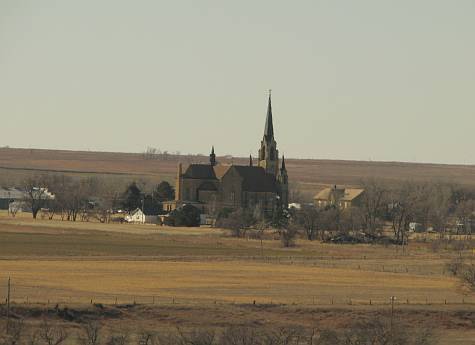Driving on the prairie, your eyes arrive long before your car. If something rises up from the land, like a grain silo or a church steeple, you’ll have time to reflect as it sprouts in your windshield. That is, unless you’re racing across the prairie, from one metropolis to another. If your mind is mired in where you’ve been and where you’re going, the plains present themselves as only a long delay in your plans.
But if you’ve got nowhere in particular to go, and you have the time, what you see on the prairie can make you think of days long past and of a future, quite indeterminate. Then, seeing a church steeple brings God to mind, “our help of ages past.” With time before you and the steeple in sight, it’s easier to know that God is “our hope for years to come, our shelter from the stormy blast, and our eternal home.”
Many of these steeples never aspired to share the blue with skyscrapers. Their churches were built for farming communities. Like the disciples in the Gospel of Luke, they’ve taken with them only what they needed for the journey: a parish house, a convent and a school.
It’s important to remember that these parishes were always “for the journey.” They came with the people of God, and they follow that flock. At the beginning of the 20th century, four out of 10 Americans lived and worked on farms. At the dawn of the 21st, only two out of 100 do.
But in central and northwestern Kansas, they built so surely, so beautifully. Seeing these limestone and brick towers reaching into the sky, not as ziggurat challenge but in a humble act of worship, you grow melancholy for times long past; you’re a little less impressed with the curtness of cities; you think of the mystery, which yet will come to claim the land as its own.
St. John the Divine saw the heavenly city of Jerusalem
What’s most curious about the journey's end, the heavenly city, is this: It has no house of worship,
Why does St. John call Christ the temple? Why does he insist that any other would be superfluous, even sacrilegious?
Some would say that all speculation about heaven is silly. Why conjecture about what cannot yet be known? Some say the same of theology itself, but the grace of sacred study is its ability to wash away false suppositions, to cleanse the mind of idols, which take the place of mystery, imposing heavy burdens upon the imagination, weights that challenge, even weaken, faith.
The Lamb is the temple of the heavenly Jerusalem, because the only God we will physically see there is the Christ who once walked among us. Rest assured that eternal repose does not consist in gazing upon an old figure on a throne and a dove. Remember that we profess God to be spirit—pure spirit, only spirit—a word that no longer carries its weight well. Anima once meant breath, it suggested invisible vitality. You don’t directly see it, yet its absence is stillness, death.
Perhaps, when we speak of God today, the words that should offset “spirit” are intelligence, freedom and creativity. Alone, these words are also insufficient. They don’t suggest love, passion and commitment. Nonetheless, in the life to come we will not “see” God the way we can now look upon a steeple, as something high and impressive. The problem, as St. Thomas Aquinas insisted, is that as pure spirit, as infinite intelligence, God will never be captured, never be contained by the human mind (Summa Theologiae I, q 12, a 2).
Yet we will look upon the glorified humanity of Jesus, just as we shall see our own, though what that will mean, and how we are to imagine it, is truly butterfly-come-from-caterpillar business. The Father and the Spirit will remain what they have always been. Pure spirit, utter creativity, sheer intelligence. Now, we see them more as pattern than as the persons they are. Perhaps therein lies the chasm between creator and creature.
But the Lamb will sit upon his throne, and we will surround that him. Alive. Together. Ever constant. In the humanity of the Christ, our physical eyes will slip into the abyss of mystery.
Steeples rise and fall. Cities crumble. But the Lamb will return for us, just as he does now in the Eucharist: physical, spiritual, glorified. The one who created humanity, the one who redeemed humanity, the one who yet loves humanity—he will gather all that is best in us to himself. The Lamb is, and will be, the eternal temple, the place where earth gives way to heaven.
Acts 15: 1-2, 22-29 Revelation 21: 10-14, 22-23 John 14: 23-29








